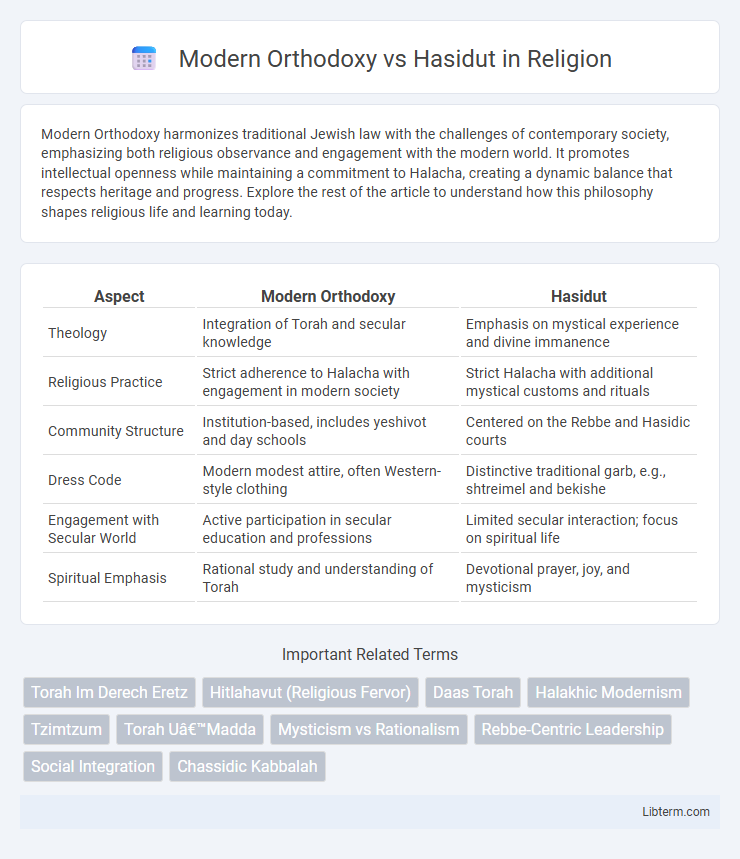Modern Orthodoxy harmonizes traditional Jewish law with the challenges of contemporary society, emphasizing both religious observance and engagement with the modern world. It promotes intellectual openness while maintaining a commitment to Halacha, creating a dynamic balance that respects heritage and progress. Explore the rest of the article to understand how this philosophy shapes religious life and learning today.
Table of Comparison
| Aspect | Modern Orthodoxy | Hasidut |
|---|---|---|
| Theology | Integration of Torah and secular knowledge | Emphasis on mystical experience and divine immanence |
| Religious Practice | Strict adherence to Halacha with engagement in modern society | Strict Halacha with additional mystical customs and rituals |
| Community Structure | Institution-based, includes yeshivot and day schools | Centered on the Rebbe and Hasidic courts |
| Dress Code | Modern modest attire, often Western-style clothing | Distinctive traditional garb, e.g., shtreimel and bekishe |
| Engagement with Secular World | Active participation in secular education and professions | Limited secular interaction; focus on spiritual life |
| Spiritual Emphasis | Rational study and understanding of Torah | Devotional prayer, joy, and mysticism |
Historical Origins: Modern Orthodoxy and Hasidut
Modern Orthodoxy emerged in 19th-century Germany as a response to Enlightenment ideals, emphasizing Torah study alongside secular knowledge and societal engagement. Hasidut originated in 18th-century Eastern Europe under the leadership of Rabbi Israel Baal Shem Tov, focusing on spiritual revival, mysticism, and joyful worship within Jewish life. Both movements shaped Jewish identity but differed fundamentally in historical context, philosophy, and religious expression.
Core Beliefs and Philosophical Foundations
Modern Orthodoxy emphasizes the integration of Torah observance with secular knowledge, valuing engagement with the modern world while maintaining strict adherence to Halacha. Hasidut centers on spiritual mysticism, emphasizing fervent prayer, joy, and a deep, experiential connection to God through the teachings of the Baal Shem Tov and subsequent Hasidic masters. Both share commitment to Jewish law but differ in philosophical approach--Modern Orthodoxy prioritizes rationalism and societal involvement, whereas Hasidut focuses on emotional devotion and mystical experience.
Approach to Halacha and Jewish Law
Modern Orthodoxy emphasizes adherence to Halacha while engaging with contemporary society and secular knowledge, advocating for a dynamic interpretation of Jewish law that accommodates modern realities. Hasidut centers on mysticism and spirituality within Halacha, prioritizing inner devotion, emotional experience, and the guidance of a Rebbe, often blending strict legal observance with heartfelt piety. Both uphold the authority of Halacha but diverge in their approach, with Modern Orthodoxy balancing tradition and modernity, whereas Hasidut infuses legal practice with mystical values and communal devotion.
Attitudes Toward Secular Knowledge and Culture
Modern Orthodoxy embraces secular knowledge and culture as complementary to Torah study, encouraging engagement with contemporary society through higher education and professional careers while maintaining halachic observance. Hasidut, in contrast, generally prioritizes spiritual devotion and mysticism over secular pursuits, often exhibiting cautious or selective attitudes toward secular culture to preserve religious intensity and communal cohesiveness. These differing approaches reflect broader tensions between integration and insularity within Jewish religious life.
Community Structure and Leadership
Modern Orthodoxy features a community structure centered on synagogues and educational institutions led by rabbis who combine traditional halachic authority with engagement in secular society. Hasidut is organized around a Rebbe, a spiritual leader who provides both religious guidance and personal mentorship, fostering a tightly-knit, devotional community. Leadership in Hasidut emphasizes dynastic succession, creating strong interpersonal bonds and centralized authority distinct from Modern Orthodoxy's more institutional model.
Role of Women in Both Movements
Modern Orthodoxy promotes increased educational and leadership roles for women, encouraging participation in religious study and community functions while maintaining traditional halachic boundaries. Hasidut emphasizes spiritual experience and communal roles often centered around traditional gender roles, with women's involvement predominantly in home and family-based religious practices. Both movements uphold Jewish law but differ significantly in the extent and nature of women's public religious engagement.
Education Systems and Priorities
Modern Orthodoxy emphasizes a dual curriculum integrating rigorous secular studies with traditional Torah learning, prioritizing intellectual engagement and preparation for active participation in broader society. Hasidut prioritizes spiritual development through immersive study of Hasidic texts, mystical teachings, and communal prayer, often within Yeshiva frameworks focused on inculcating piety and devotion. The educational systems reflect these values: Modern Orthodox schools balance general studies and Jewish law, while Hasidic schools concentrate predominantly on Talmudic and Hasidic philosophy, shaping distinct community identities and life goals.
Religious Practices and Daily Life
Modern Orthodoxy emphasizes engagement with secular knowledge and modern society while adhering strictly to Halacha, blending religious observance with contemporary life, such as participating in higher education and professional careers. Hasidut centers on mystical devotion, spiritual fervor, and community-centric practices, with daily life marked by repetitive prayer customs, distinctive dress, and adherence to the teachings of a Rebbe. Religious observances in Hasidut often involve intense prayer experiences and joy, whereas Modern Orthodoxy integrates religious rituals within a framework that supports secular involvement and modern challenges.
Interaction with Broader Society
Modern Orthodoxy maintains active engagement with broader society through secular education and professional participation, fostering a balance between Jewish law and contemporary culture. Hasidut emphasizes insular spiritual devotion and community life, often limiting interaction with external cultural influences to preserve religious authenticity. The contrasting approaches reflect Modern Orthodoxy's openness to integration versus Hasidut's focus on distinct communal identity.
Challenges and Future Directions
Modern Orthodoxy faces challenges integrating secular knowledge with traditional Halacha, balancing religious observance and contemporary societal norms, while Hasidut struggles with preserving mystical spirituality amid modern secular influences. Both movements encounter tensions in maintaining community cohesion and identity amid increasing modernity and globalization. Future directions likely involve adaptive educational frameworks and digital platforms to sustain engagement while preserving core theological principles.
Modern Orthodoxy Infographic

 libterm.com
libterm.com